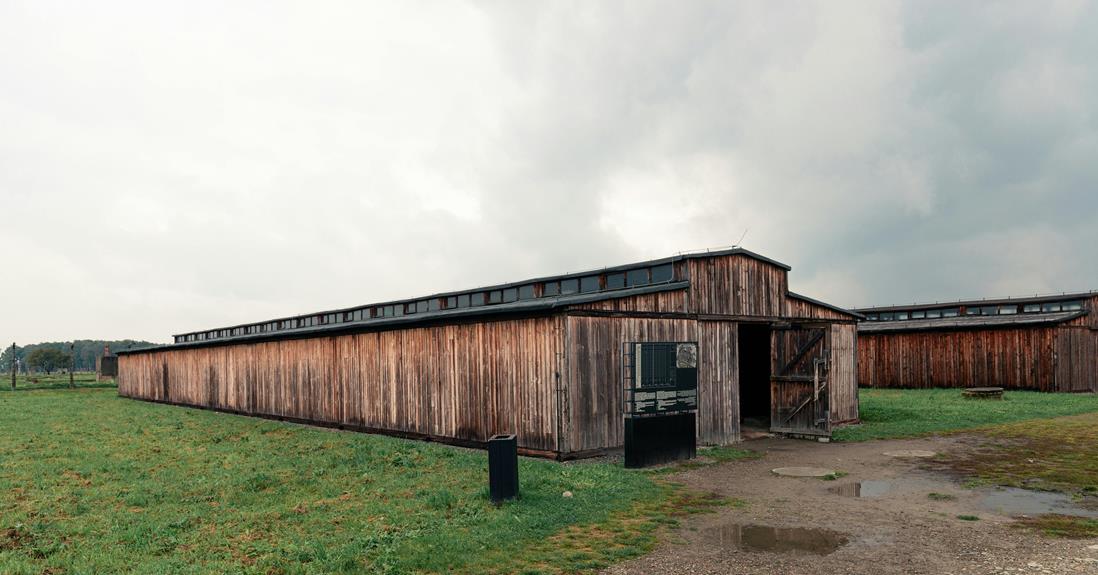Nestled within the landscape of Poland, Treblinka silently carries the weight of a dark past that unfolded within its borders. The mere mention of this place evokes memories of a time when humanity was at its lowest, and the horrors that transpired there are etched into the annals of history. A visit to Treblinka is not merely a journey to a physical location but a haunting exploration of the depths of human cruelty and resilience. There is a story waiting to be uncovered, one that sheds light on the strength of the human spirit amidst unimaginable adversity.
Key Takeaways
- Treblinka was a Nazi extermination camp in Poland during WWII.
- Over 800,000 Polish Jews died in Treblinka in 15 months.
- The memorial site in present-day Poland honors Holocaust victims.
- Survivor testimonies showcase human resilience at Treblinka.
- Remembrance events educate about the Holocaust and combat discrimination.
Historical Background
During the tumultuous years of World War II, Treblinka, Poland, became a site of unspeakable tragedy and horror. Under Nazi occupation, Treblinka played a devastating role in the systematic genocide of Jewish people. The Nazis established the Treblinka extermination camp in 1942 as part of Operation Reinhard, a plan aimed at annihilating Polish Jews.
The camp's primary purpose was the mass murder of Jews through gas chambers and crematoriums. Treblinka was one of the most efficient killing centers, with estimates suggesting that over 800,000 people lost their lives there in a span of just 15 months. The victims were transported to Treblinka in crowded cattle cars, often enduring horrific conditions during the journey.
Jewish persecution at Treblinka was relentless and brutal. Upon arrival, victims were stripped of their belongings, separated from their families, and forced into gas chambers disguised as showers. The Nazis exploited the vulnerability of their victims, subjecting them to unimaginable suffering and dehumanization.
The horrors of Treblinka serve as a stark reminder of the atrocities committed during the Holocaust. The site stands as a tribute to the resilience of the human spirit in the face of unspeakable evil, urging future generations to remember the past and work towards a world free from oppression and hatred.
Memorial Site Overview
Located in present-day Poland, the memorial site at Treblinka stands as a solemn tribute to the victims of one of the most horrific chapters in human history. The site serves as a poignant reminder of the atrocities committed during the Holocaust, where thousands of innocent lives were brutally taken.
Commemoration ceremonies are regularly held at the Treblinka memorial site to honor the memory of those who perished there. These ceremonies provide an opportunity for individuals from around the world to come together and pay their respects to the victims, ensuring that their stories are never forgotten. Additionally, educational programs are an integral part of the site, aimed at educating visitors about the history of Treblinka and the broader context of the Holocaust. These programs aim to promote understanding, tolerance, and remembrance, emphasizing the importance of learning from the past to prevent such horrors from happening again.
The memorial site at Treblinka stands as a somber yet essential landmark, serving as a place of reflection, remembrance, and education. Through commemoration ceremonies and educational programs, the site continues to fulfill its duty of preserving the memory of the victims and educating future generations about the dark realities of the Holocaust.
The Camp Layout
The layout of the Treblinka camp was meticulously designed to facilitate the efficient and systematic extermination of its victims. The architectural significance of the camp's layout played a pivotal role in the horrors that unfolded within its confines. The camp was divided into two main sections: the reception area and the extermination area.
The reception area, where victims arrived by train, was deceptively designed to appear as a transit camp. It included facilities such as a fake ticket office and a phony medical area to maintain the illusion of normality. Once the victims were offloaded, they were stripped of their belongings and forced to proceed along the 'Tube,' a narrow path leading to the gas chambers.
In contrast, the extermination area was where the most heinous crimes took place. It consisted of the gas chambers, mass graves, and crematoria. The gas chambers were camouflaged as shower rooms to prevent panic among the incoming victims. After the mass killings, bodies were disposed of in the mass graves or burned in the crematoria.
The table below provides a summarized overview of the layout details of the Treblinka camp:
| Area | Description |
|---|---|
| Reception Area | Deceptive facilities to maintain calmness |
| Extermination Area | Gas chambers, mass graves, crematoria |
This layout, with its calculated design and sinister purpose, stands as a stark reminder of the atrocities committed during the Holocaust.
Stories of Survival
Numerous accounts of resilience and courage have emerged from individuals who survived the harrowing ordeal of Treblinka, shedding light on the human spirit's unwavering strength in the face of unimaginable suffering. These survivor testimonies serve as poignant reminders of the atrocities committed during the Holocaust, but also as beacons of hope amidst darkness.
One such story is that of Samuel Willenberg, who was one of the few Treblinka survivors. Willenberg's harrowing experience and eventual escape from the camp provide a testament to the human will to survive even in the most desperate circumstances. His detailed recollections of the horrors he witnessed and endured serve as a vital historical record, ensuring that the voices of the victims are never silenced.
Similarly, the accounts of other survivors like Kalman Taigman and Richard Glazar offer profound insights into the resilience and hope that sustained them through the darkest of days. Their stories depict acts of bravery, solidarity, and kindness that emerged even within the confines of a place designed to extinguish all humanity.
These survivor testimonies not only bear witness to the atrocities of Treblinka but also stand as a tribute to the indomitable human spirit. They remind us of the importance of preserving these stories of survival, resilience, and hope so that future generations may learn from the past and work towards creating a more just and compassionate world.
Importance of Remembrance
Stories of survival from Treblinka underscore the essential significance of remembrance in preserving the legacy of those who endured unimaginable atrocities during the Holocaust. Holocaust education plays a vital role in ensuring that the horrors of the past are not forgotten but serve as a reminder of the consequences of hatred and intolerance. By commemorating the victims of Treblinka and other Nazi death camps through various events and initiatives, we honor their memory and endeavor to prevent such atrocities from ever happening again.
Commemoration events, such as memorial services, museum exhibitions, and educational programs, provide opportunities for individuals to learn about the Holocaust, reflect on its impact, and pay tribute to the millions who perished. These events also serve as a platform for survivors and their descendants to share their stories, ensuring that the lessons of the Holocaust are passed down to future generations.
Remembrance is not only about honoring the past but also about shaping the future. By remembering the victims of Treblinka and other Holocaust atrocities, we reaffirm our commitment to upholding human rights, promoting tolerance, and combating discrimination in all its forms. Through education and remembrance, we aim to create a world where such atrocities can never happen again.
Frequently Asked Questions
How Many Victims Were Estimated to Have Perished in Treblinka?
In evaluating the number of victims estimated to have perished, considerations about estimation accuracy and historical significance are paramount. The challenge lies in reconciling available data, survivor testimonies, and archival records to arrive at a credible estimate.
The accuracy of these estimations is vital in preserving the historical memory of the tragic events and honoring the lives lost. Balancing sensitivity and rigor is essential in commemorating and understanding such monumental tragedies.
What Measures Are in Place to Prevent Vandalism at the Memorial Site?
Security measures at memorial sites are essential to prevent vandalism and safeguard the preservation of historical significance. These measures often include surveillance cameras, security patrols, fencing, and restricted access.
Community involvement is also vital, as local support can enhance monitoring efforts and foster a sense of collective responsibility for safeguarding these important sites.
Are There Any Ongoing Archaeological Excavations at Treblinka?
Ironically, while some may picture archaeological excavations as glamorous adventures unraveling mysteries of the past, the reality is often meticulous, painstaking work.
In various locations, ongoing excavations continue to unearth valuable archaeological findings that shed light on the historical significance of the sites.
These endeavors contribute essential insights into the past, enriching our understanding of civilizations and cultures that have shaped the world we inhabit today.
How Has the Local Community Been Involved in Preserving the Site?
Community engagement plays a pivotal role in preserving sites of historical significance. Local communities often contribute by providing valuable insights, support, and firsthand accounts that enrich the preservation efforts. Their involvement fosters a sense of ownership and pride in conserving cultural heritage.
Involving the local community in preserving historical sites is not only beneficial for the site itself but also strengthens the bond between the community and its history, ensuring a collective effort towards conservation.
What Educational Programs Are Available for Visitors at Treblinka?
Educational programs at this historical site offer immersive experiences through interactive workshops and informative guided tours. These programs aim to engage visitors in a dynamic learning environment, fostering a deeper understanding of the site's significance.
Conclusion
To sum up, the memorial site in Treblinka, Poland serves as a poignant proof to the tragic events that unfolded during World War II.
Through its somber reminder of the atrocities committed, it stands as a place for reflection and education on the importance of remembering the victims.
The camp's layout and stories of survival offer a glimpse into the harrowing experiences faced by those who suffered there, emphasizing the need to never forget the horrors of the past.


